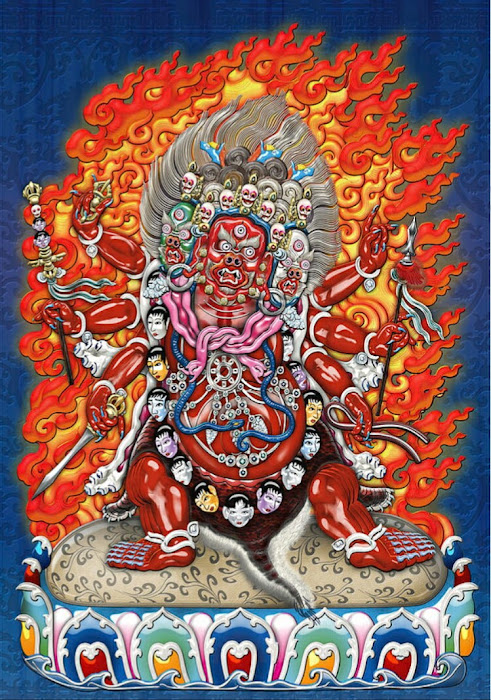Heruka ( Sanskrit ) Tibetan: ( Khrag Thung), is the name of a category of wrathful deities, enlightened beings in Vajrayana Buddhism that adopt a fierce countenance to benefit sentient beings. In East Asia, these are called Wisdom Kings.
Herukas represent the embodiment of indivisible bliss and emptiness. They appear as Istha-devata (Tibetan: Yidam) or meditational deities for Tantric Sadhana, usually placed in a mandala and often appearing in Yab-Yum.
Heruka represents wrathful imagery with indivisible emptiness (Sunyata), bliss, peace, wisdom, compassion (Bodhicitta), and love. Herukas represent unified consciousness, with emptiness being a reflection of "non-phenomena" or emptiness which is "all love," or removal of imagery to reach universal love, mercy, and compassion-mind. Interpretation of Heruka is similar to the female Dakiṇi or Buddha Vajrayogini.
The Nyingma mahayoga tradition (and their corresponding sadhanas) are said to have been received by Padmakara from the Eight Vidyadharas or Eight Great Acharyas: Manjushrimitra, Nagarjuna, Vajrahumkara, Vimalamitra, Prabhahasti, Dhanasamskrita, Shintamgarbha and Guhyachandra. They were proficient in the practices of, respectively:
*(No.7) Lokastotrapuja-natha (Tibetan :Jigten Chotod) the wrathful Ksitigarbha, the deity of worldly offering and praise.
* Footnote
For those who had received the empowerment of this Tantric practice, you are reminded not intentionally or unintentionally to disclose the mantra to the public or anyone who may not have the empowerment or permission to practice, and by disclosing the mantra intentionally or unintentionally is a form of breaking your Tantric Samaya vows to the lineage masters and Dharma protectors.
Please consult your Guru or a qualified lineage master for Vajrayana practice! Should a devotee even want to start studying and contemplating the Vajrayana practice, then it is truly necessary to first have completed the preliminaries and to be certain and sure that Bodhicitta has arisen and developed in one’s mind.
Vajrayana features countless skillful and powerful methods which, if they are practiced in the proper way, can make the process of accumulation and purification incredibly swift and direct. It is absolutely necessary to have the pure motivation and to know that Vajrayana practice is not carried out to increase one’s own ego, power and self-interests.
Donations for our Buddhist research and development
Do you earnestly cherish our devoted work? Assuming this is the case, we are delighted that you are finding our blog useful and valuable. Would you consider making a donation for our Buddhist research and development?
We need your help to secure the future of scholarly interaction with Buddhism. Since our very first publication of Dharma works and activities in the year 2008, we had been effortlessly providing free distribution of Dharma posts and articles throughout the previous 14 years. We have exceptionally constrained supports and do not receive subsidized or funding from people in general.
Please help us and to develop our Dharma activities that will not only benefit you, but to all Dharma readers on the planet. Please consider showing your support. Your generosity will certainly help us to enhance our work and to accomplish for a better and brighter prospect to come.
Thank you for reading, may you find peace and great bliss. With your support it helps to spread the Buddha’s precious teachings and turning the Dharma wheels in the world.
Aspiration For Bodhichitta
For those in whom the precious Bodhichitta has not arisen
May it arise and not decrease
But increase further and further.
Dedication of Merit
By this merit may we obtain omniscience then.
Having defeated the enemies wrong-doings.
May we liberate migratory from the ocean of existence.
With its stormy waves of birth, old age, sickness and death.
*Note
I do not own or infringe any copyright of the picture(s).
Picture(s) courtesy and credit to the rightful distributors and or studios.
Picture(s) is/are intended for editorial use only.






















.jpg)











